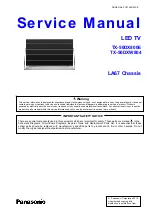
Circuit Descriptions, Abbreviation List, and IC Data Sheets
EN 133
FTL2.1E, FTL2.2E
9.
The keyboard press detection is done by communication via
the RC5/6 line. Because the OTC already receives the
information KEYBOARD_PRESS, we can use the
communication protocol between the OTC and the
microcontroller via the RC5/6 line to switch "on" the blue LEDs.
9.8
Ambient Light (if present)
9.8.1
Introduction
At the rear left and right side of the TV-set, three gas
discharging lamps are mounted. With the red, green, and blue
lamps, each colour can be made.
•
Ambient light is adjustable with three variables: Hue,
Saturation, and Brightness.
•
Hue and saturation are controlled via menu control or via
smart settings.
•
The brightness is controlled via menu or via a cycle
generator.
•
The light sensor influences the brightness.
•
Switching "on" or "off" goes via a ramp up or down.
•
The ambient light may be active or passive.
In the user set up menu the following items are added:
•
Ambient Light.
•
Lights "On/Off".
•
Ambient Light: "Personal/Normal/Warm/Cool".
Two extra keys are added on the Remote Control:
•
ON/OFF: A (normal) press on this key switches the
Ambient Light "On/Off".
•
MODE: In case the set is "On", to toggle the smart modes.
Specifications:
•
Lamp current frequency= 43 kHz.
•
Lamp dimming frequency= 85 Hz.
•
PWM duty cycle range= 30 %
•
Each lamp is only driven one third of the period to avoid
crosstalk (drive lamps at 33.3 % to have no losses in
output).
9.8.2
Block diagram
Figure 9-10 Ambient light block diagram
All mentioned blocks (from "Cycle Generator" to "HSV-to-RGB
Converter" are implemented in the main software. Via I
2
C, the
RGB values are sent to the EPLD (where a selection is made
between "active" and "passive" mode) and again via I
2
C the
Inverter board is addressed.
In "passive" mode, the RGB values from the "HSV-to-RGB
Converter" are used, while in "active" mode the picture content
is used to steer the ambient lights.
Cycle Generator
The Cycle Generator (for fade in/out) starts with a long press
on the "On/Off" button on the RC. It stops when the button is
released.
Light sensor
The light sensor influences the Brightness: when the room is
darker, the ambient light is reduced. The amount of dimming is
set according to an algorithm in the Auto TV software. In
"active" Ambient Light mode, the light sensor does not
influence the Brightness.
Ramp Up/down
The Brightness is changing with a speed from min. to max. in
2 s.
HSV to RGB converter.
The HSV (Hue, Saturation, Value) values are converted to
RGB values.
Outputs
The outputs are RGB values and can individually be
decreased.
The EPLD
In "passive" mode, the EPLD sends the info from the OTC
directly to the inverter board. In "active" mode, the EPLD
calculates the RGB values. Hue and Saturation are not
adjustable, Brightness is adjustable.
9.8.3
Inverter Board
This board is for Service a "Black Box". This means that it is not
repairable on component level, but if it is defect, the board must
be swapped. See the Spare Parts List for the order code.
Some specifications:
•
There are three inverters to drive the lamps, each inverter
drives the Left and Right lamp for one colour.
•
DC-to-AC converter: 2.3 kV.
SW1
GND
Light sensor
Passive/Active AL
E_14620_007.eps
070504
HSV to RGB
Converter
SetHue (H)
SetSaturation (S)
SetValue (V)
Start
CyclingValue
SetLightState
Stop
RGB
EPLD
RED left
RED right
GREEN left
GREEN right
BLUE left
BLUE right
RED
inverter
Inverter board
CCFL
GREEN
inverter
BLUE
inverter
RampUp
Down
Profiles
personal
Profiles
Picture
content
Cycle
Generator
OTC SOFTWARE
SW2
















































